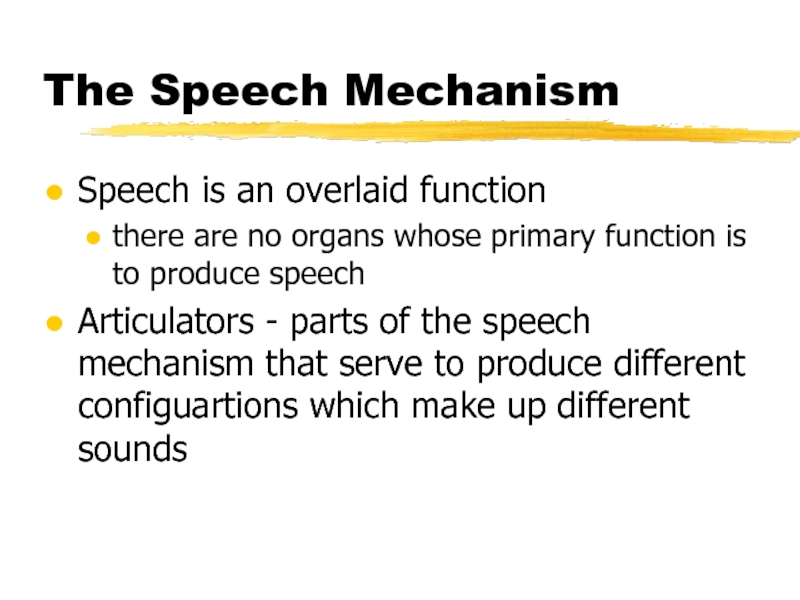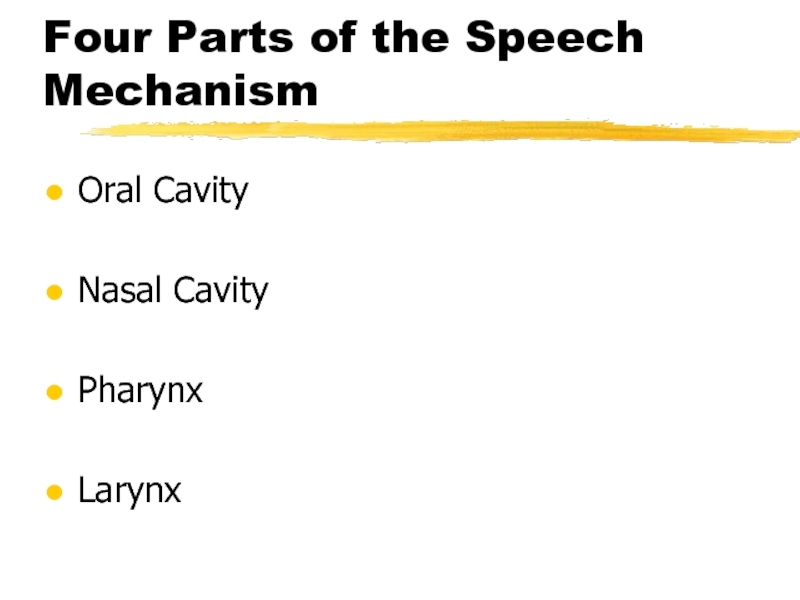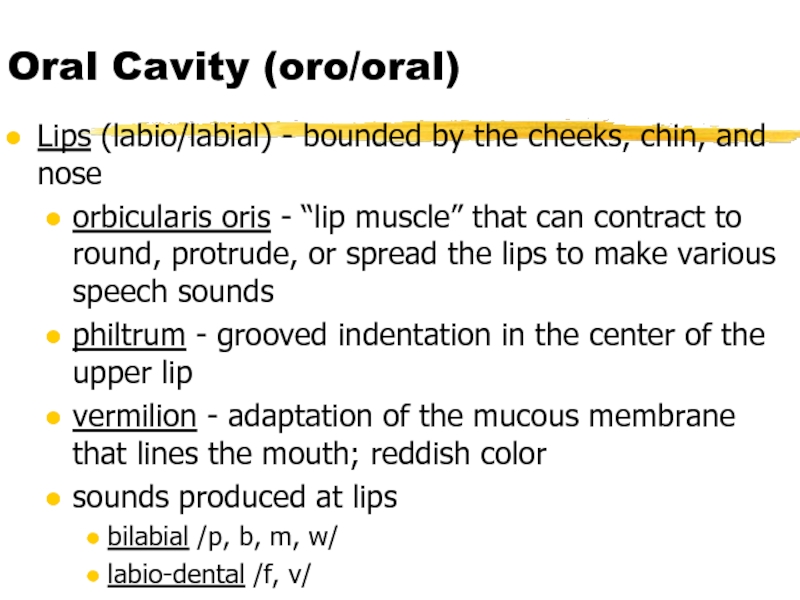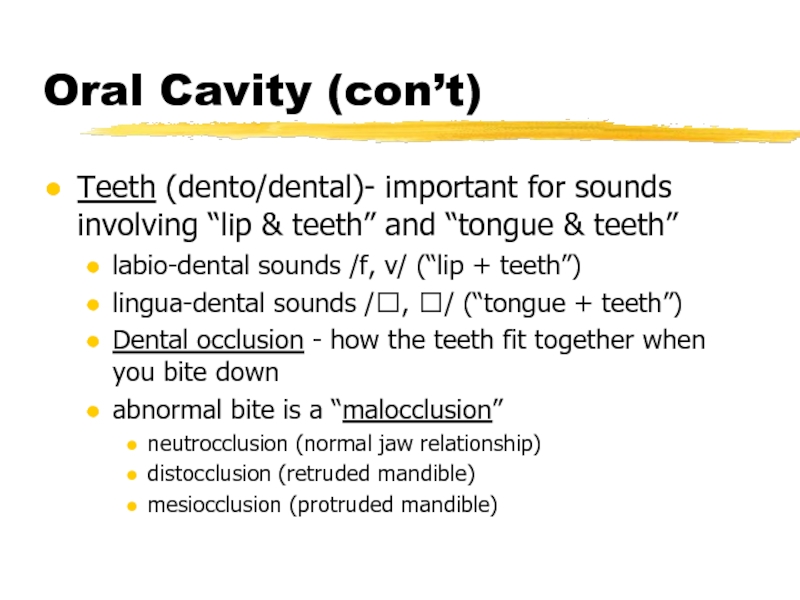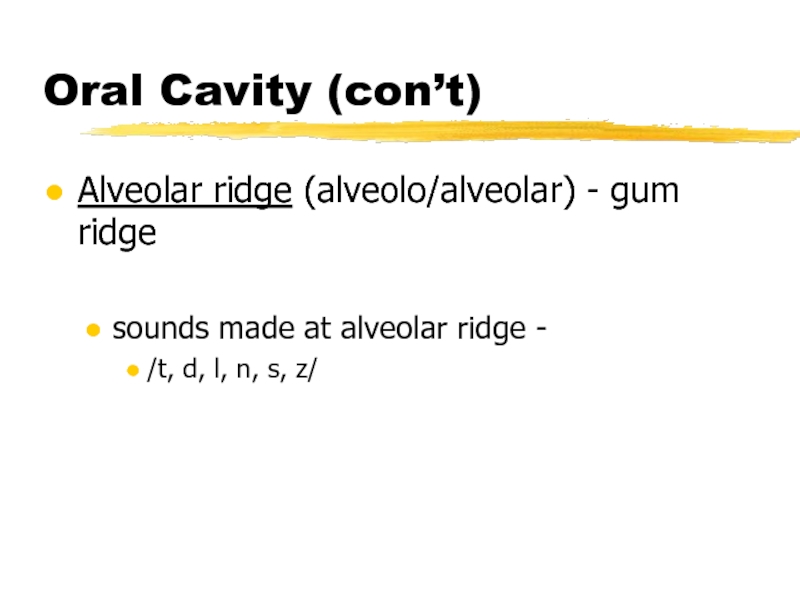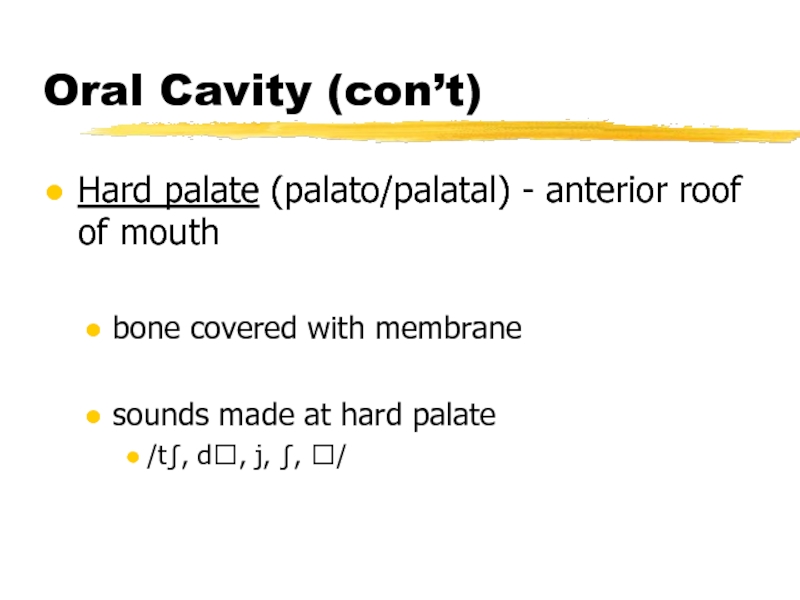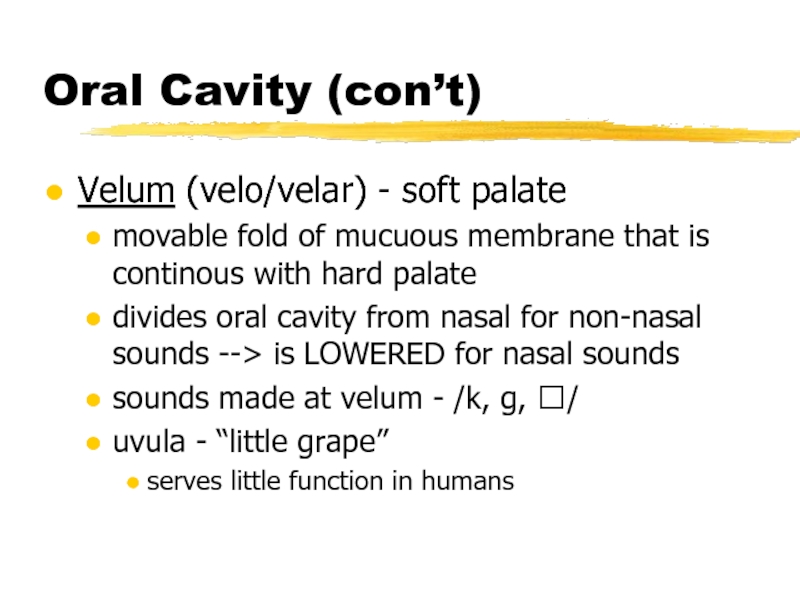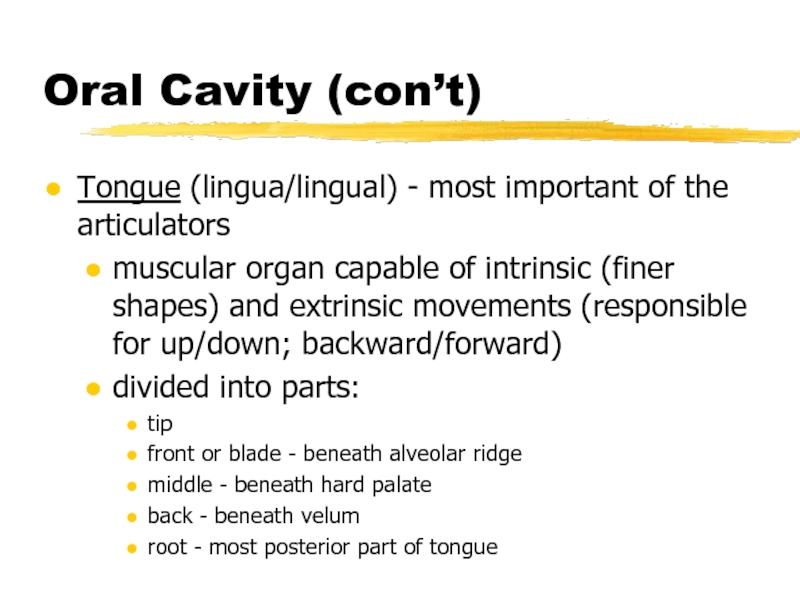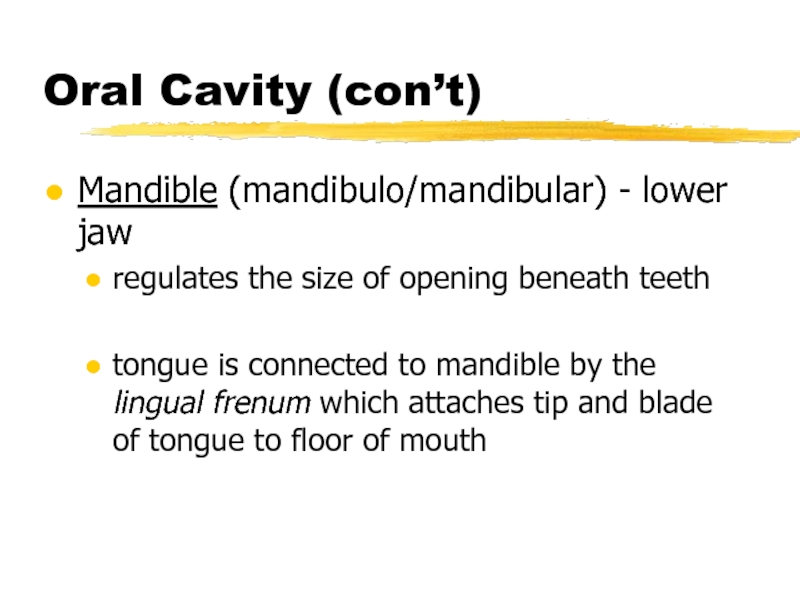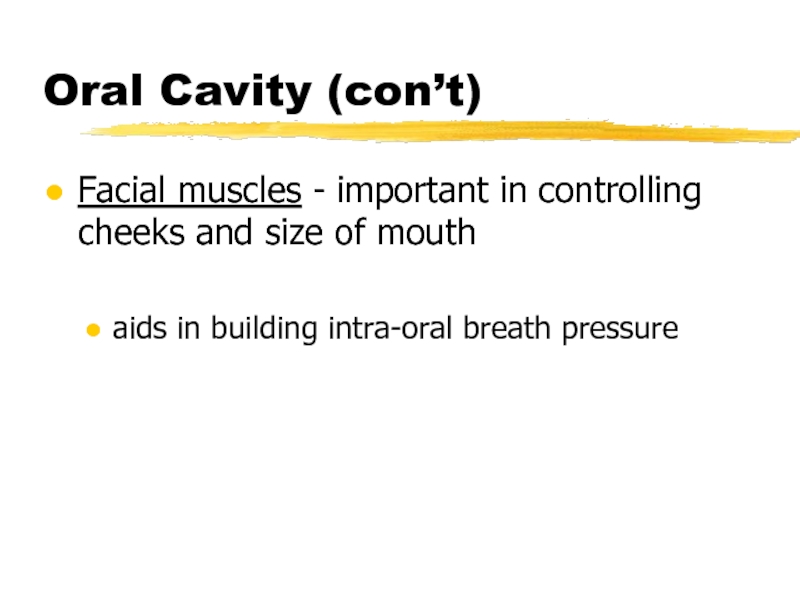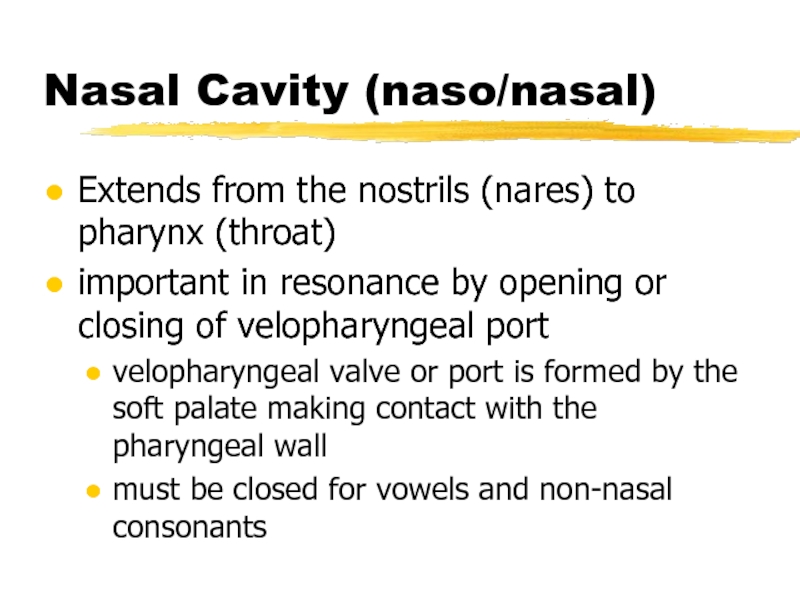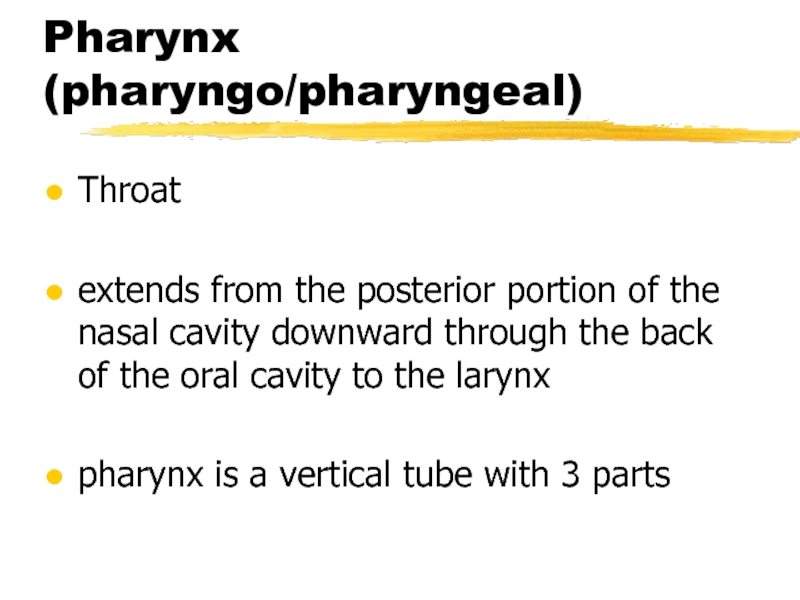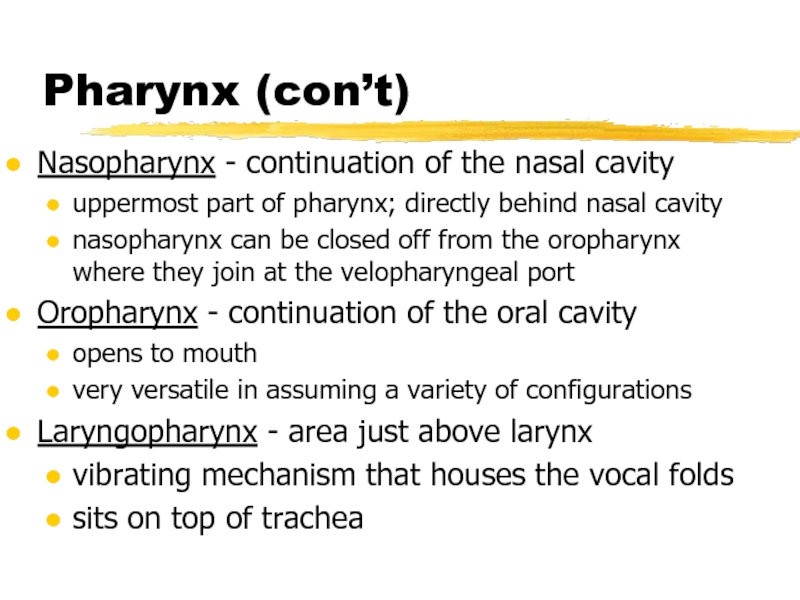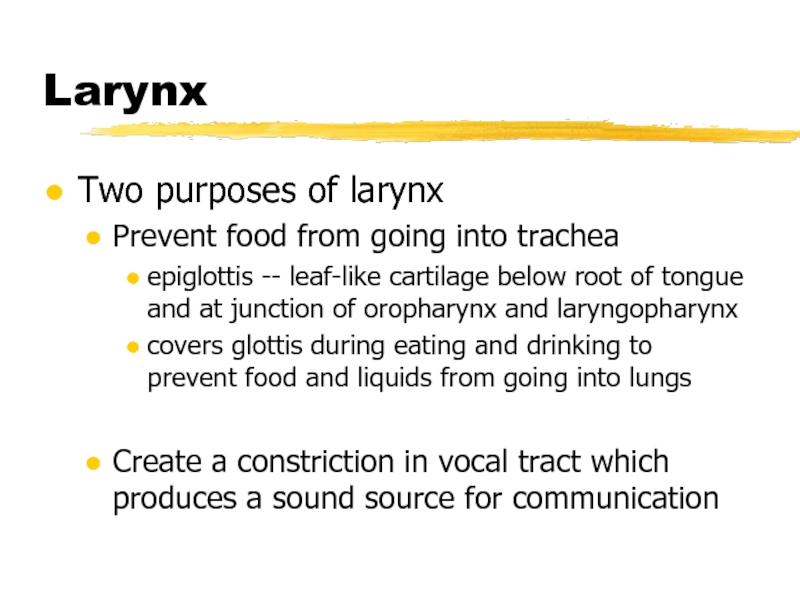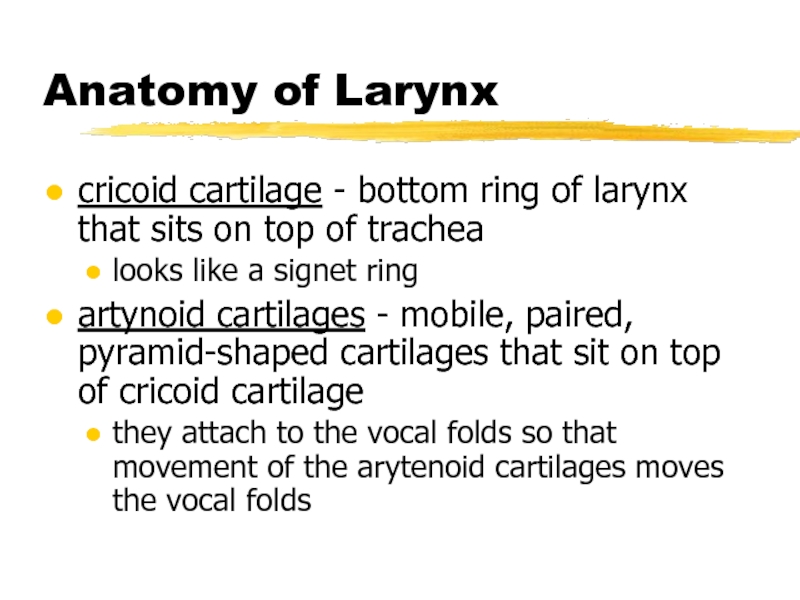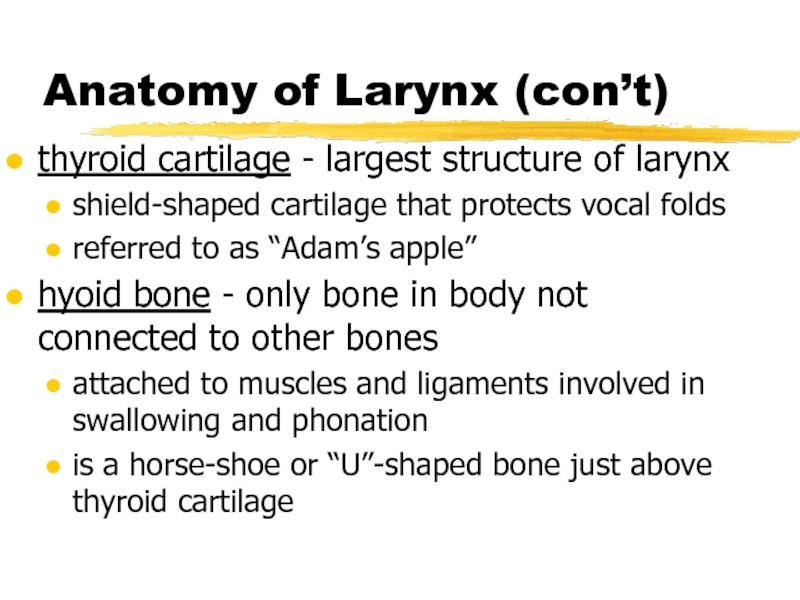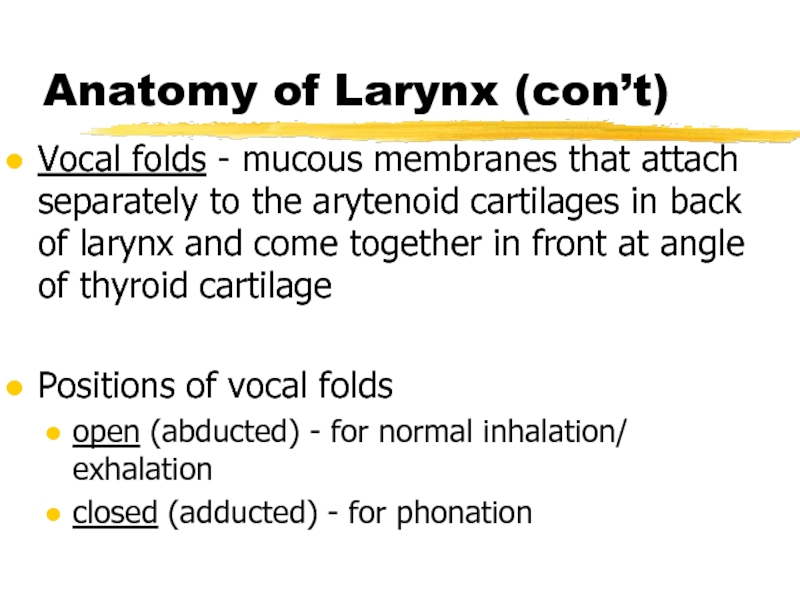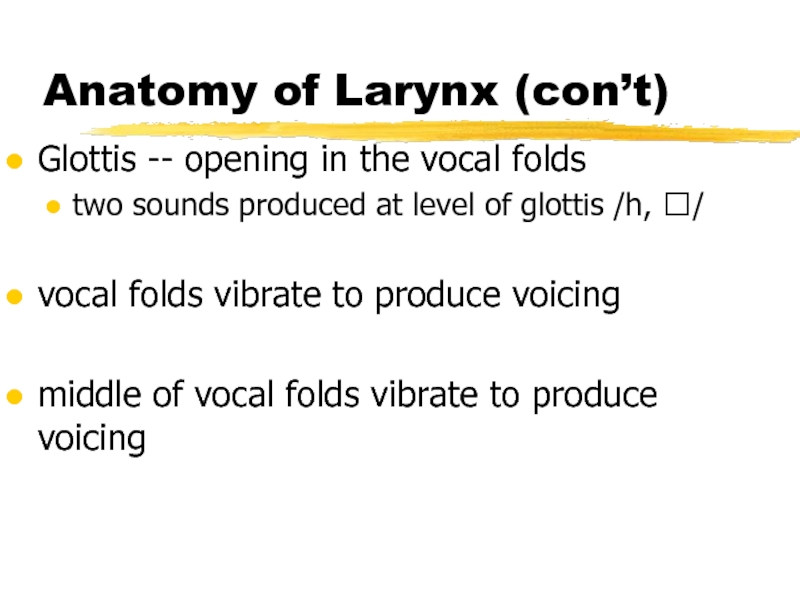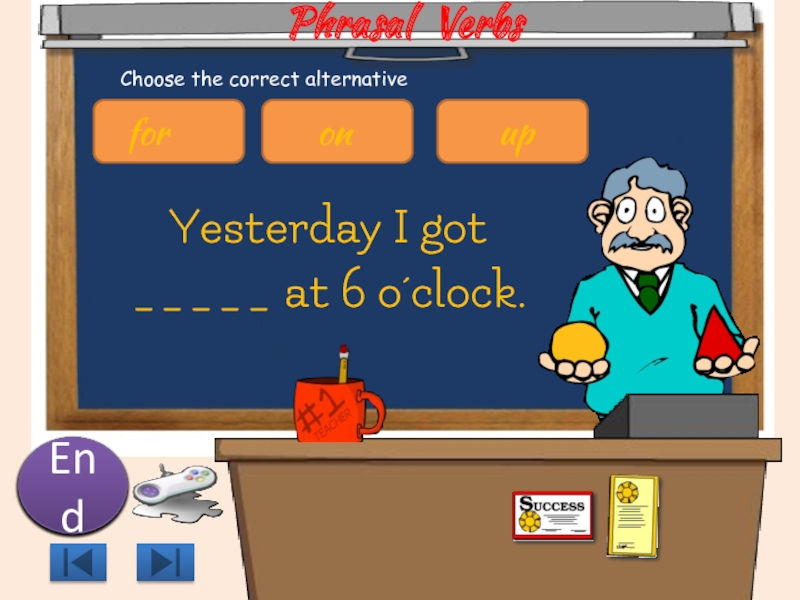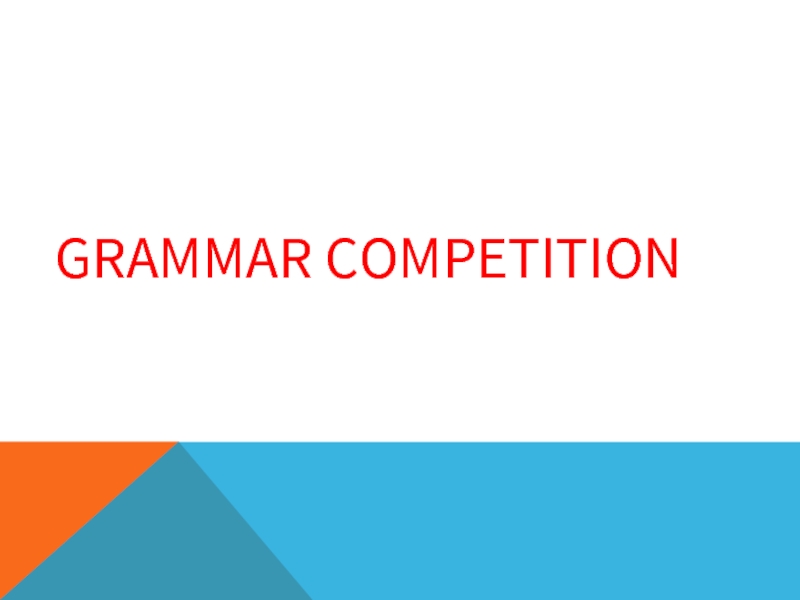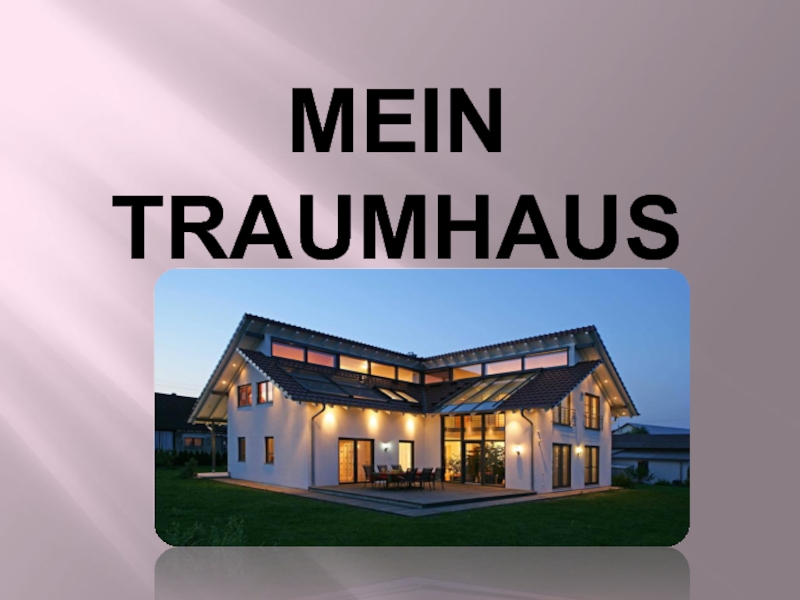primary function is to produce speech
Articulators - parts of the speech mechanism that serve to produce different configuartions which make up different sounds
- Главная
- Разное
- Дизайн
- Бизнес и предпринимательство
- Аналитика
- Образование
- Развлечения
- Красота и здоровье
- Финансы
- Государство
- Путешествия
- Спорт
- Недвижимость
- Армия
- Графика
- Культурология
- Еда и кулинария
- Лингвистика
- Английский язык
- Астрономия
- Алгебра
- Биология
- География
- Детские презентации
- Информатика
- История
- Литература
- Маркетинг
- Математика
- Медицина
- Менеджмент
- Музыка
- МХК
- Немецкий язык
- ОБЖ
- Обществознание
- Окружающий мир
- Педагогика
- Русский язык
- Технология
- Физика
- Философия
- Химия
- Шаблоны, картинки для презентаций
- Экология
- Экономика
- Юриспруденция
The Speech Mechanism презентация
Содержание
- 1. The Speech Mechanism
- 2. Four Parts of the Speech Mechanism Oral Cavity Nasal Cavity Pharynx Larynx
- 3. Oral Cavity (oro/oral) Lips (labio/labial) - bounded
- 4. Oral Cavity (con’t) Teeth (dento/dental)- important for
- 5. Oral Cavity (con’t) Alveolar ridge (alveolo/alveolar) -
- 6. Oral Cavity (con’t) Hard palate (palato/palatal) -
- 7. Oral Cavity (con’t) Velum (velo/velar) - soft
- 8. Oral Cavity (con’t) Tongue (lingua/lingual) - most
- 9. Oral Cavity (con’t) Mandible (mandibulo/mandibular) - lower
- 10. Oral Cavity (con’t) Facial muscles - important
- 11. Nasal Cavity (naso/nasal) Extends from the nostrils
- 12. Pharynx (pharyngo/pharyngeal) Throat extends from the
- 13. Pharynx (con’t) Nasopharynx - continuation of the
- 14. Larynx Two purposes of larynx Prevent food
- 15. Anatomy of Larynx cricoid cartilage - bottom
- 16. Anatomy of Larynx (con’t) thyroid cartilage -
- 17. Anatomy of Larynx (con’t) Vocal folds -
- 18. Anatomy of Larynx (con’t) Glottis -- opening
Слайд 3Oral Cavity (oro/oral)
Lips (labio/labial) - bounded by the cheeks, chin, and
nose
orbicularis oris - “lip muscle” that can contract to round, protrude, or spread the lips to make various speech sounds
philtrum - grooved indentation in the center of the upper lip
vermilion - adaptation of the mucous membrane that lines the mouth; reddish color
sounds produced at lips
bilabial /p, b, m, w/
labio-dental /f, v/
orbicularis oris - “lip muscle” that can contract to round, protrude, or spread the lips to make various speech sounds
philtrum - grooved indentation in the center of the upper lip
vermilion - adaptation of the mucous membrane that lines the mouth; reddish color
sounds produced at lips
bilabial /p, b, m, w/
labio-dental /f, v/
Слайд 4Oral Cavity (con’t)
Teeth (dento/dental)- important for sounds involving “lip & teeth”
and “tongue & teeth”
labio-dental sounds /f, v/ (“lip + teeth”)
lingua-dental sounds /, / (“tongue + teeth”)
Dental occlusion - how the teeth fit together when you bite down
abnormal bite is a “malocclusion”
neutrocclusion (normal jaw relationship)
distocclusion (retruded mandible)
mesiocclusion (protruded mandible)
labio-dental sounds /f, v/ (“lip + teeth”)
lingua-dental sounds /, / (“tongue + teeth”)
Dental occlusion - how the teeth fit together when you bite down
abnormal bite is a “malocclusion”
neutrocclusion (normal jaw relationship)
distocclusion (retruded mandible)
mesiocclusion (protruded mandible)
Слайд 5Oral Cavity (con’t)
Alveolar ridge (alveolo/alveolar) - gum ridge
sounds made at alveolar
ridge -
/t, d, l, n, s, z/
/t, d, l, n, s, z/
Слайд 6Oral Cavity (con’t)
Hard palate (palato/palatal) - anterior roof of mouth
bone covered
with membrane
sounds made at hard palate
/t∫, d, j, ∫, /
sounds made at hard palate
/t∫, d, j, ∫, /
Слайд 7Oral Cavity (con’t)
Velum (velo/velar) - soft palate
movable fold of mucuous membrane
that is continous with hard palate
divides oral cavity from nasal for non-nasal sounds --> is LOWERED for nasal sounds
sounds made at velum - /k, g, /
uvula - “little grape”
serves little function in humans
divides oral cavity from nasal for non-nasal sounds --> is LOWERED for nasal sounds
sounds made at velum - /k, g, /
uvula - “little grape”
serves little function in humans
Слайд 8Oral Cavity (con’t)
Tongue (lingua/lingual) - most important of the articulators
muscular organ
capable of intrinsic (finer shapes) and extrinsic movements (responsible for up/down; backward/forward)
divided into parts:
tip
front or blade - beneath alveolar ridge
middle - beneath hard palate
back - beneath velum
root - most posterior part of tongue
divided into parts:
tip
front or blade - beneath alveolar ridge
middle - beneath hard palate
back - beneath velum
root - most posterior part of tongue
Слайд 9Oral Cavity (con’t)
Mandible (mandibulo/mandibular) - lower jaw
regulates the size of opening
beneath teeth
tongue is connected to mandible by the lingual frenum which attaches tip and blade of tongue to floor of mouth
tongue is connected to mandible by the lingual frenum which attaches tip and blade of tongue to floor of mouth
Слайд 10Oral Cavity (con’t)
Facial muscles - important in controlling cheeks and size
of mouth
aids in building intra-oral breath pressure
aids in building intra-oral breath pressure
Слайд 11Nasal Cavity (naso/nasal)
Extends from the nostrils (nares) to pharynx (throat)
important in
resonance by opening or closing of velopharyngeal port
velopharyngeal valve or port is formed by the soft palate making contact with the pharyngeal wall
must be closed for vowels and non-nasal consonants
velopharyngeal valve or port is formed by the soft palate making contact with the pharyngeal wall
must be closed for vowels and non-nasal consonants
Слайд 12Pharynx (pharyngo/pharyngeal)
Throat
extends from the posterior portion of the nasal cavity downward
through the back of the oral cavity to the larynx
pharynx is a vertical tube with 3 parts
pharynx is a vertical tube with 3 parts
Слайд 13Pharynx (con’t)
Nasopharynx - continuation of the nasal cavity
uppermost part of pharynx;
directly behind nasal cavity
nasopharynx can be closed off from the oropharynx where they join at the velopharyngeal port
Oropharynx - continuation of the oral cavity
opens to mouth
very versatile in assuming a variety of configurations
Laryngopharynx - area just above larynx
vibrating mechanism that houses the vocal folds
sits on top of trachea
nasopharynx can be closed off from the oropharynx where they join at the velopharyngeal port
Oropharynx - continuation of the oral cavity
opens to mouth
very versatile in assuming a variety of configurations
Laryngopharynx - area just above larynx
vibrating mechanism that houses the vocal folds
sits on top of trachea
Слайд 14Larynx
Two purposes of larynx
Prevent food from going into trachea
epiglottis -- leaf-like
cartilage below root of tongue and at junction of oropharynx and laryngopharynx
covers glottis during eating and drinking to prevent food and liquids from going into lungs
Create a constriction in vocal tract which produces a sound source for communication
covers glottis during eating and drinking to prevent food and liquids from going into lungs
Create a constriction in vocal tract which produces a sound source for communication
Слайд 15Anatomy of Larynx
cricoid cartilage - bottom ring of larynx that sits
on top of trachea
looks like a signet ring
artynoid cartilages - mobile, paired, pyramid-shaped cartilages that sit on top of cricoid cartilage
they attach to the vocal folds so that movement of the arytenoid cartilages moves the vocal folds
looks like a signet ring
artynoid cartilages - mobile, paired, pyramid-shaped cartilages that sit on top of cricoid cartilage
they attach to the vocal folds so that movement of the arytenoid cartilages moves the vocal folds
Слайд 16Anatomy of Larynx (con’t)
thyroid cartilage - largest structure of larynx
shield-shaped cartilage
that protects vocal folds
referred to as “Adam’s apple”
hyoid bone - only bone in body not connected to other bones
attached to muscles and ligaments involved in swallowing and phonation
is a horse-shoe or “U”-shaped bone just above thyroid cartilage
referred to as “Adam’s apple”
hyoid bone - only bone in body not connected to other bones
attached to muscles and ligaments involved in swallowing and phonation
is a horse-shoe or “U”-shaped bone just above thyroid cartilage
Слайд 17Anatomy of Larynx (con’t)
Vocal folds - mucous membranes that attach separately
to the arytenoid cartilages in back of larynx and come together in front at angle of thyroid cartilage
Positions of vocal folds
open (abducted) - for normal inhalation/ exhalation
closed (adducted) - for phonation
Positions of vocal folds
open (abducted) - for normal inhalation/ exhalation
closed (adducted) - for phonation
Слайд 18Anatomy of Larynx (con’t)
Glottis -- opening in the vocal folds
two sounds
produced at level of glottis /h, /
vocal folds vibrate to produce voicing
middle of vocal folds vibrate to produce voicing
vocal folds vibrate to produce voicing
middle of vocal folds vibrate to produce voicing
